
I also take Ali swimming in the rivers around Portland. They are great in the summer but get very cold in the winter, so during the cold months the indoor pool is an ideal substitute. Now that the weather has finally warmed up here, I have been taking him swimming in rivers again. Sometimes lately he has been sluggish and not very interested in walking around the neighborhood, but he always perks up when I bring him to water! These two photos are from a recent excursion to one of our regular swimming haunts at George Rogers Park, south of Portland:
Alec has a very interesting relationship with water. When I adopted him seven years ago, he did not like it. Not long after he came to live with me in Georgia, we were on a hike and passed a small waterfall and Alec began biting and barking at the swirling water in the pool at the bottom. This was the first time I noticed something strange. I had tried to encourage him to swim but he was not interested, until one day I placed his ball just a foot or two into a gentle creek. His desire for his ball overcame his apprehension about the water, and he waded in. Ever since then, Alec has liked to swim, but he still barks at moving water. He becomes very agitated in the presence of waves (river or ocean); he will growl and grumble at them and sometimes bark using his high pitched “woof!” as he paces back and forth biting at the water in his adorable and strange way.
I took Alec to the coast a couple weeks ago on Father's Day and he had a good time patrolling the beach and playing in the waves (he does not swim in the ocean, just splashes around):


 Here are some more photos from our trip to Cannon Beach.
Here are some more photos from our trip to Cannon Beach. I learned the hard way that Alec’s obsession with water means I have to keep him close anytime we are near it – especially if there are waves. Alec is a natural “heeler,” and when we are away from traffic and other dogs I often take him off his leash because he never goes far and never, ever runs away from me. Of course there are always exceptions, which is why I am such an advocate of dogs being leashed most of the time! However, at the risk of sounding like the most incompetent dog guardian ever, I will relay this harrowing tale:
One morning when we were living in San Francisco, I walked with Ali out to the Sutro Baths (ruins of an old public bath house right on the beach), where there is a lovely little promontory that overlooks the ocean. It was very early in the morning, and when we rounded the corner and I saw no one else was out there, I unsnapped Ali's leash. To my surprise and horror, he ran straight for the 4 ft. wall encircling the overlook, and, without hesitating, scrambled up and over this wall while I was still shouting his name. Miraculously he landed on a ledge halfway between the top of the cliff and the rocks below, but he was stranded there because the rock face was too vertical for him to climb up or down without falling. And I could not get to him. To make a long story short, Alec was rescued by the wonderful San Francisco Fire Department that morning (with only a small scrape on his paw) and I never made that mistake again! Alec had never done anything like this before and I realized afterward what prompted him to leap the wall; he heard the ocean waves and mistakenly thought the beach was right on the other side of the wall, rather than a story or two down. A close call that still makes me shudder!


 Once she got the climbing harness attached to Alec, she rappelled to the bottom holding him against her body. My hero! The firefighters were so sweet and told me how much they loved their own dogs as I thanked them over and over. As Alec and I walked back home, I was shaking from the aftereffects of my panic-fueled adrenaline rush. Alec, on the other hand, was completely unfazed and the first thing he did was grab a stick to play with!
Once she got the climbing harness attached to Alec, she rappelled to the bottom holding him against her body. My hero! The firefighters were so sweet and told me how much they loved their own dogs as I thanked them over and over. As Alec and I walked back home, I was shaking from the aftereffects of my panic-fueled adrenaline rush. Alec, on the other hand, was completely unfazed and the first thing he did was grab a stick to play with! I will wrap up with a general plug for hydrotherapy (not defined as jumping off a cliff into the ocean!). Although I swim Alec now mainly for fun and exercise, I cannot overemphasize the importance of water to his recovery from paralysis (not just free swimming, but the underwater treadmill too). Swimming is not only great rehabilitation for dogs with neurological conditions like disc disease, but it is also helpful for many other common ailments like arthritis, hip dysplasia, degenerative myelopathy, or even recovery following injuries. For this reason, if your dog is not a natural born “water dog,” you might want to get her used to the water now before she has a problem that could benefit from hydrotherapy.
It obviously helps if your dog likes the water and is motivated to chase a ball other toy. However, even if your dog does not like the water now, this could change with positive reinforcement and the right motivation. As I mentioned, when I adopted Alec he would not go near the water, but he was so toy-motivated that I was able to coax him in one day using his ball as bait, and from that day on he loved to swim. So you never know! I thanked my lucky stars many times during Alec's rehabilitation that he liked the water so much. Because swimming can be therapeutic for so many conditions – in addition to providing an important physical and psychological outlet for dogs with mobility restrictions – I think it would not be a bad idea for every guardian to help their dog get comfortable with water while they are healthy, just in case. Again, you never know.
If you are considering swimming with a mobility-challenged companion, please use caution. Before we had the indoor pool option, I started out swimming Alec in various rivers. Alec is a very smooth swimmer and I was always careful to keep him submerged in the water as much as possible so that he was mostly treading water, rather than coming in and out, which would have caused more stress on his joints (I was always hip deep in the water in the beginning, now I usually only wade in up to my knees). If your dog gets wild in the water or is not a smooth swimmer, this is probably not the best activity for him if he is recovering from a back injury. If you can get him to walk in the water along the river’s edge that would be okay, but free swimming would not be a good option for a dog who may thrash or be rambunctious. Just use your judgment and talk to your dog’s physical therapist if you have one. I can only say what it seemed to do for Ali. Also, never put your disabled dog in the water without a life vest.

Until very recently, I always had Ali wear his "float coat" (Ruff Wear makes a good one, modeled by Ali here) when in the river as a safety precaution, just in case. And if you are trying to get your dog in a pond, lake, or river for the first time, enter the water with him and hold onto the life vest until you are absolutely sure of his ability. It was a long time before I was comfortable standing on the shore tossing the ball for Alec.







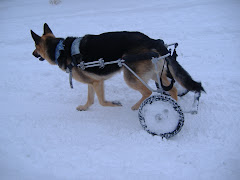
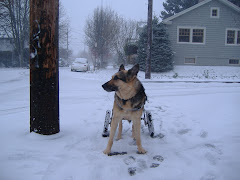
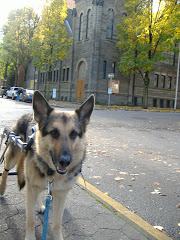

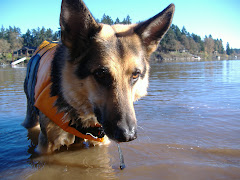

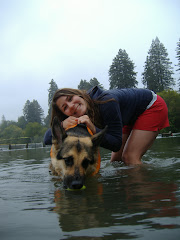_9_19_08+030.jpg)

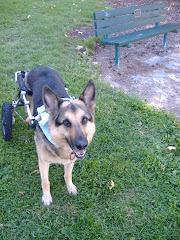
_9_19_08+045.jpg)
_9_19_08+001.jpg)
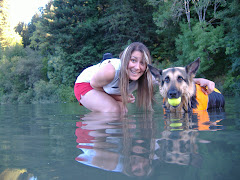
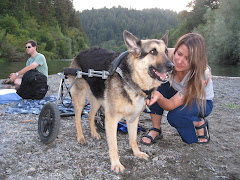
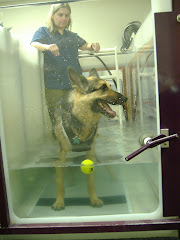
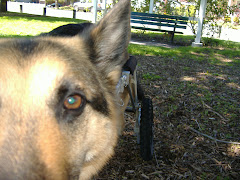
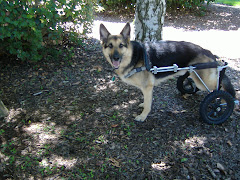
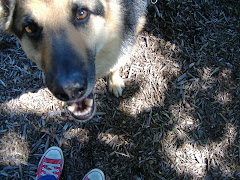

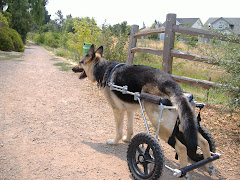
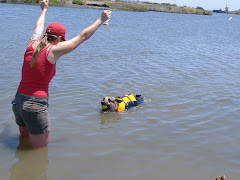
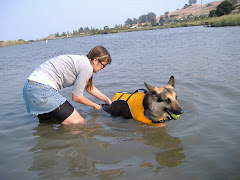

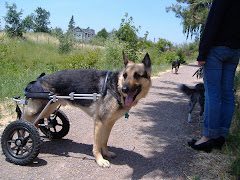


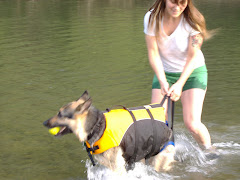
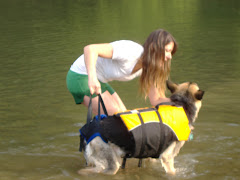
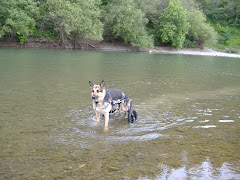

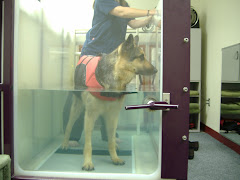

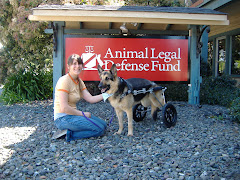
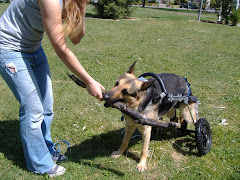


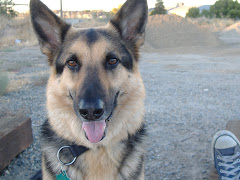









2 comments:
Keep the faith. Sending love from Canada. I am thankful to read about all the hydro adventures and to imagine Alec doing his favorite thing - swimming! I am sure heaven for him will be one long river or an endless pool! Love you & Ali.
Though I'm so sorry to hear that last part, I must post my initial thought--which has been with me since I first heard of Alec's Story (from Steve). He is so full of joy! You write of how much you love him and it is so clear how much he loves you.
Post a Comment